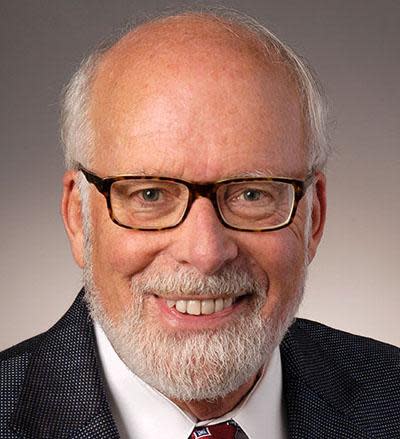Chuck Douglas: What can we do about homelessness? Here's what works
With the rise in rents and the cost of housing, as well as the end of COVID-19 eviction protections, the number of people who are homeless rose to 582,500 last year, according to the Department of Housing and Urban Development.
That number is up 13% since 2020. Not just L.A. or New York, but across the nation, the hopeless individuals, and scared families who find themselves on the street, are not all there due to drugs or mental health issues.
Columbus, Ohio counted 2,337 homeless on Jan. 25, 2023, up 22% over 2022. Rent rises of 68% for apartments in the Phoenix area drove a 7% homeless increase in Maricopa County between 2017 and 2022. Los Angeles County’s 75,518 homeless grew by 10% last year.

A new approach to this now decade old problem is simple and effective — give the homeless a home. Studies now show that a place to live is the first step in helping stabilizing the homeless. Leading the way is Houston, Texas with a program called The Way Home.
In 2011, the Houston area had one of the largest homeless populations in the country. With the threat of homelessness not only increasing, and dismay over decades of substantial investments without results propelled the community into action.
Since 2012, more than 28,000 people who experienced homelessness in the greater Houston area have been housed. This has resulted in a more than a 60% decrease in overall homelessness in just over a decade.
So what changed? In 2012, the city and county came together as a unified regional homeless response system called The Way Home and chose a nonprofit coalition for the homeless of Houston/Harris county as lead agency.
Marc Eichenbaum, special assistant to the mayor, and Michael Nicolas, CEO of the Coalition, recently explained how the breakthrough occurred in a June 9, CNN interview. They said “ we housed the most vulnerable people first. When the average person sees someone experiencing homelessness and struggling with mental illness, they assume that the individual is dangerous or needs hospitalization. Our experience is that most of these folks stabilize in housing with the appropriate level of services.”
Moreover, they said they have found that most people “fall into homelessness, because of rapid and unexpected financial losses — those that needn’t result in catastrophe, if only we had the right policies in place. Homelessness often exacerbates mental health deterioration and the need to self medicate. In other words, mental illness is not the driver of homelessness in most cases.”
Thus, they embraced the results of Housing First, a strategy focused on getting individuals and families out of homelessness in into permanent housing before helping them address any other problems. “We do this via voluntary wraparound support services, e.g., mental health or substance abuse, counseling, health, care, job training, and so on. The services help keep the person housed, and the housing is what makes the services effective,” according to Nicholas and Eichenbaum.
They also got all of the people with a stake in resolving the homeless problem together in the Coalition:
“We decided to work together as a collaborative system, aligned around a standardized set of goals, processes and strategies, rather than as individual organizations and government entities each trying to chip away at the problem. Today, more than 100 entries in the Houston area are working together in combining their efforts and resources to move the needle on reducing homelessness. Our collaboration includes using a centralized database to capture information and track the service needs of people experiencing homelessness and using a standardized assessment to determine which housing and/or service interventions best suit each household.”
Prior to collaboration they noted the same endless cycle seen in New Hampshire and elsewhere “where the local mental health authority, the local veterans affairs office, law enforcement and the public health response system, many organizations have responded and attempted to help with limited sustained success.”
Not only is it the moral thing to do if you believe — as do I — that you are your brother's keeper, but it saves tax dollars! As the two reformers noted “ it is less expensive to Houston individual and provide services (we estimate about $18,000 per year) then the multiple of cost of putting people in jail, or allowing them to suffer on the streets and being forced to make regular use of our emergency rooms (which national estimates ranch from $30,000 to $50,000 and up).”
The three parts of the Housing First children’s program are simple, but effective:
“First, we provide an actual home — most often an apartment — with a key, a lease in the person's name, and everything needed to stay in that unit for the long-haul. Second, we give them a subsidy for the rent. Depending on the program, residents may still contribute 30% of their income. Finally, we ensure support services to help the person move forward, psychologically, emotionally and financially.”
Does it work? Nicolas and Eichenbaum offer hope to the hundreds of thousands in need:
“Houston has not solved homelessness in its entirety. But by investing in proven, effective intervention — housing — we are making homelessness, rare, brief and nonrecurring for people. In fact, in our latest performance evaluation period, approximately 90% of people we helped house did not fall back into homelessness for at least two years.”
It is time for each city and county to look at those folks with the cardboard signs at our intersections not as a lost cause, but a shared responsibility we should begin meeting.
Chuck Douglas is a former judge and New Hampshire 2nd District Republican U.S. congressman. He wrote this column originally for The Bow Times, which he publishes.
This article originally appeared on Portsmouth Herald: Chuck Douglas: What can we do about homelessness? Here's what works
